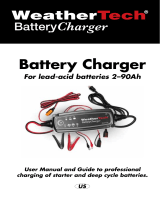
• 17 •
MODO DE DESULFATACIÓN
La desulfatación puede durar 8 a 10
horas. Si la desulfatación falla, la carga se
abortará y luz LED Bad Battery (rojo) se
encenderá.
FINALIZACIÓN DE LA CARGA
La nalización de la carga se indica con
el LED Cargada (verde). Cuando está
encendido, el cargador ha pasado de
modo de función a mantenimiento.
MODO DE MANTENIMIENTO
(MONITOREO A MODO DE FLOTE)
Cuando la luz LED Cargado /
Mantenimiento (verde) esté encendido,
quiere decir que pasó al modo de
mantenimiento. En este modo el
cargador mantiene la batería totalmente
cargada mediante una pequeña corriente
cuando corresponda. Si el cargador
tiene que funcionar a una corriente de
mantenimiento excesiva a un periodo
de 12 horas, se transladará al Modo
de Interrumpir (véase la sección Carga
Anulada). Esto es ocacionalmente
causado por una pérdida de energía en la
batería o la batería está dañada.
MANTENIENDO UNA BATERÍA
La unidad carga y mantiene las baterías
de 12 voltios, manteniéndolas a carga
completa.
NOTA: La tecnología de modo de
mantenimiento le permite cargar de
forma segura y mantener una batería
en buen estado durante largos períodos
de tiempo. Ahora, los problemas con
la batería, problemas eléctricos del
vehículo, conexiones equivocadas u otras
condiciones que surgan, podrías causar
absorsión de corriente excesiva. De modo
que, ocasionalmente seguimiento de su
batería y el proceso de carga se requiere.
UTILIZAR LA FUNCIÓN
DE ENCENDIDO DE MOTOR
El cargador de batería se puede utilizar
para impulsar el auto si la batería está
baja. Siga todas las instrucciones y
precauciones de seguridad en la carga de
la batería. Use protección completo de los
ojos y la ropa de protección.
ADVERTENCIA: Utilizando la función de
arranque del motor sin la batería instalada
en el vehículo, dañará el sistema eléctrico.
NOTA: Si usted ya ha cargado la batería y
aún no arranca el auto, no utilice la opción
de arranque, porque esto podría dañar
el sistema eléctrico del vehículo. Haga
revisar la batería.
1. Con el cargador desenchufado del
tomacorriente de C.A., conecte el
cargador a la batería siguiendo las
instrucciones que guran en la sección
Siga Estos Pasos Cuando la Batería
Esté Colocada en el Vehículo.
2. Enchufe el cable de alimentación de
CA del cargador al tomacorriente 120
Voltios CA con conexión a tierra.
3. Con el cargador enchufado y
conectado a la batería y al chasis,
presione el botón de Selección de
Velocidad hasta que se encienda el
LED de Arranque del Motor y luego
presione el botón START.
4. Déle arranque al motor hasta que
se ponga en marcha o que pasen 7
segundos. If the engine does
not start, repeat. No haga arrancar
la unidad durante el período de
enfriamiento (vea la información
siguiente). Esto permite al cargador y
la batería que se enfríen. NOTA: Bajo
clima frío extremo o si la batería es
inferior a 2 volts, cargue la batería por
5 minutos antes de poner en marcha
el motor.
5. Si el motor no arranca, cargue la
batería por 5 minutos más antes de
darle arranque nuevamente.
6. Después de que el motor se puso
en marcha desenchufe el cable
de alimentación de CA antes de
desconectar las pinzas de la batería
del vehículo.
7. Limpie y guarde el cargador en un
lugar seco.
NOTA: Si el motor gira, pero no enciende,
no existe un problema con el sistema de
arranque, sino en cualquier otra parte
del vehículo. DEJE de darle arranque
al motor hasta que el otro problema se
diagnostique y se corrija.
NOTAS SOBRE EL ARRANQUE
DEL MOTOR
En la secuencia de arranque que gura
anteriormente el cargador se congura en
uno de estos cuatro estados:
• Espere a que la unidad esté lista –
El cargador carga la batería por 2 minutos
antes de quedar en estado de Espera
de Arranque. Mientras espera a que la
unidad esté lista, podrá hacer arrancar el
motor. Para baterías muy descargadas,
no se recomienda el arranque en este
momento.




















